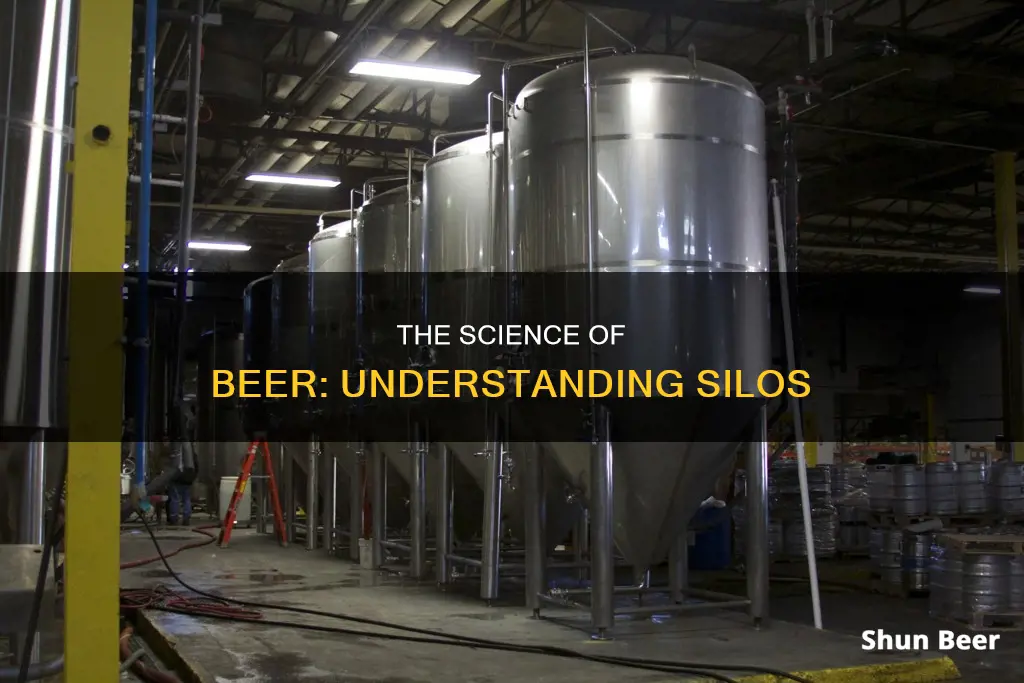
Beer silos are an essential component of the brewing process, offering significant advantages to breweries of all sizes. They are large structures used for storing grain/malt, the base ingredient of beer, in bulk quantities. By enabling bulk storage and automating malt handling, breweries can streamline their processes, reduce labour costs, and make substantial economic savings. This article will explore the inner workings of beer silos, including their design, functionality, and the benefits they bring to the brewing industry.
| Characteristics | Values |
|---|---|
| Purpose | To store grain/malt |
| Benefits | Store grain/malt for longer, save money on labour, free up floor space |
| Types | Round, welded, smooth-walled; corrugated galvanised bolted; square |
| Materials | Mild steel; stainless steel; powder-coated steel |
| Features | Dust-tight discharge gates; level indicators; leak-proof; custom dimensions |
| Capacity | ~50,000 lbs |
What You'll Learn

How to choose the right silo for your brewery
When choosing a silo for your brewery, there are several factors to consider to ensure you make the right choice. Firstly, you should determine the volume of malt you will need to store, taking into account your monthly brewing output and the recommended storage time for malt, which is typically around three months. This will help you decide on the appropriate size of the silo.
The next step is to consider the space you have available for the silo. Silos come in different shapes, with round silos being the most common choice for brewers, followed by square silos, which are less frequently used. The diameter and height of the silo will depend on the space you have, as well as any local access and transportation restrictions. It is important to hire an engineer to design a sturdy pad that can withstand the weight of the fully loaded silo and comply with local codes and regulations.
The type of silo you choose is another crucial factor. Most brewers opt for either welded, smooth-walled silos or corrugated galvanized bolted silos, both of which are made of mild steel. Welded silos offer superior sealing against moisture and can be customized to meet special design requirements, but their size may be limited by shipping constraints. On the other hand, corrugated bolted silos are often less expensive and can be manufactured in larger sizes, making them suitable for installation in hard-to-access rooms. However, they require more effort for moisture and dust sealing.
Finally, consider the additional features and accessories that can enhance the functionality and safety of your silo. This includes level indicators, access hatches, dust collection systems, and custom discharges to prevent infestations and leakage. By carefully considering these factors, you can choose the right silo that meets the specific needs of your brewery.
Tums to the Rescue: Beer Sickness Solution?
You may want to see also

The economic benefits of using a silo
A silo is a structure for storing bulk materials, such as grain, coal, cement, and food products. In the context of breweries, silos are used for storing grain or malt in bulk. Using a silo offers several economic benefits, including:
Cost Savings on Grain:
By purchasing grain in bulk, breweries can achieve significant cost savings. Silos also allow for longer storage of grain or malt, reducing the need for frequent purchases.
Increased Production Capacity:
Adding capacity to a grain silo can effectively increase the overall size and speed of production. This, in turn, can lead to higher output and potentially lower costs per unit.
Space Efficiency:
Silos can be placed outdoors, freeing up valuable indoor floor space. This additional space can be utilised for other purposes, such as experimenting with new seasonal brews or expanding operations.
Reduced Labour Costs:
The automated systems in silos save a significant amount of money in labour hours. The efficient handling of bulk materials reduces the manual labour required, improving productivity and potentially reducing labour costs.
Simplified Malt Handling:
A properly designed silo simplifies malt handling automation, making the overall brewing process more efficient. This can lead to reduced costs and faster production times.
Energy and Alcohol: Do Beer and Red Bull Work?
You may want to see also

The importance of regular maintenance
Beer silos are a significant investment for breweries, and regular maintenance is essential to ensure optimal performance and a positive return on investment. Here are some reasons why regular maintenance of beer silos is crucial:
Preventative Care
Regular maintenance allows for the early detection and resolution of minor issues before they escalate into more significant problems. This proactive approach helps to extend the lifespan of the silo, avoiding costly repairs or premature replacement.
Efficient Brewing Operations
Proper maintenance of beer silos contributes to the overall efficiency of the brewing process. Well-maintained silos enable brewers to optimize their production flow, reducing downtime and maximizing output. This efficiency is crucial to meeting market demands and ensuring a consistent supply of beer.
Product Quality
Regular maintenance helps maintain the integrity of the stored grain or malt, which is essential for beer quality. By preventing issues such as moisture ingress, insect infestations, and corrosion, brewers can safeguard their ingredients and, by extension, the final product.
Safety
Beer silos require regular inspections and maintenance to ensure they meet safety standards. This includes checking for structural integrity, proper functionality of access points, and the condition of equipment such as ladders, railings, and extraction mechanisms. Well-maintained silos provide a safer working environment for brewery personnel.
Cost Savings
Proper maintenance can lead to significant cost savings. By preventing equipment malfunctions and prolonging the lifespan of the silo, breweries can avoid unexpected repair or replacement expenses. Additionally, well-maintained silos help optimize ingredient usage, minimize waste, and reduce labor costs associated with manual handling.
In summary, regular maintenance of beer silos is vital to ensure the smooth operation of brewing facilities, maintain product quality, enhance safety, and maximize the return on investment. By prioritizing preventative care and adhering to maintenance best practices, breweries can reap the full benefits of their beer silos.
Beer Traps: Effective Earwig Control or Urban Myth?
You may want to see also

The process of filling a silo
Filling a silo is a complex process that requires careful planning and execution. Here is a step-by-step guide to the process of filling a beer silo:
Firstly, it is important to determine the size of the silo. This involves calculating the maximum barrels per month that will be brewed to estimate the monthly malt requirements. It is recommended to store around three months' worth of malt, ensuring that it doesn't sit for more than five months. The diameter and height of the silo will depend on the available space and local code restrictions.
Once the size is determined, the brewery should hire an engineer to design a sturdy pad that can withstand the weight of the fully loaded silo, including seismic and wind loads. The silo footplates will be bolted to this pad.
Before filling the silo, it is important to ensure that the malt is fresh and of good quality. Malt is the most expensive ingredient in beer, and it is recommended to use it within three months to avoid staling. Ordering early and taking regular inventory are crucial to ensure a consistent supply.
When the malt is ready, it can be loaded into the silo. The most common method is to use a PD truck that pneumatically blows the malt into the top of the silo. A brewery team member should be present during delivery to ensure that the truck operator does not push the malt at a pressure higher than 3.5 psi, as higher pressures can damage the malt and create unnecessary dust. It typically takes 2-3 hours to unload a truck.
During the filling process, it is important to monitor the pressure and rate to avoid damaging the malt. Some products can withstand up to 5 psi, but it is crucial to respect the limit to prevent creating dust and causing unnecessary damage.
After the silo is filled, it is important to inspect it regularly and empty it periodically to prevent dust buildup and infestation. This involves ensuring that the discharge gate is sealed properly to prevent leaks and that filter bags are used on the silo exhaust vent to minimise dust.
Kegerator and Stella: A Perfect Match?
You may want to see also

How to ensure the safety of workers when using a silo
Working with beer silos can be dangerous, even for the most experienced workers. Working with silos can involve working at heights, working in confined spaces, and working with machinery, presenting a range of safety risks. Here are some detailed instructions to ensure the safety of workers when using a silo:
Site Selection, Preparation, and Installation:
- Evaluate the proposed location to ensure it can support the loads and has adequate drainage to prevent flooding and subsidence.
- Install foundations according to the manufacturer's instructions, ensuring safe vehicle access to and from public roads.
- Ensure the stored substance and loading/unloading rates are within the manufacturer's specifications.
- Maintain sufficient distances from other buildings and facilities to allow safe access and egress from work areas.
Emergency Planning:
- Develop, document, and communicate a site emergency plan to all workers and contractors.
- Implement measures to rescue trapped workers, including fall prevention/arrest systems.
- Install detectors for heat, smoke, and fire where required, and create a site map outlining the location of plant, equipment, and silos for emergency services.
- Establish procedures for confined space entry, evacuation in case of fire, and ancillary plant isolation.
Signs and Warnings:
- Display signs on each container/equipment, warning of hazards and outlining procedures.
- Identify confined spaces and prohibit unauthorised entry with appropriate signage.
- Display warning signs for allowable loads on conveyors and augers, fall prevention/arrest devices, and transportable conveyors/augers.
- Ensure outward-opening hatches warn of streaming substances, and provide training to workers on safety procedures, including confined space entry and emergency procedures.
Ladder, Top Hatch, and Fall Hazards:
- Control fall hazards, both inside and outside containers, by eliminating or reducing the need for access to heights and ladders.
- Provide less hazardous means of access, such as inclined ladders or drones for inspection.
- Install fall prevention/arrest systems, such as guard railings and safety cages, and warning signs for elevated areas.
- Ensure access to ladders/elevated areas is restricted to authorised personnel, and that ground-operated lid/hatch opening systems are functioning properly.
Confined Space and Entrapment Risks:
- Eliminate the need for confined space entry if possible, and conduct hazard risk assessments prior to entry.
- Lock access doors and barriers to prevent unauthorised access, especially by children.
- Deny access to the inside of the container via ladders and keep children away from machinery areas.
- Identify the potential for entrapment, atmospheric contamination, and unsafe atmospheres.
- Provide lifting equipment, harnesses, or lifeline arrangements for rescue procedures, and test the atmosphere within the container for combustible gases, vapours, dusts, and toxic agents.
Electrical Safety:
- Identify the position of overhead power lines, determine voltage, and establish safe working distances.
- Ensure safe distances from power lines for grain-breaking poles and truck and auger travel routes.
- Lower augers when moved or towed, and fit residual current devices (RCDs) to all power outlets.
- Regularly inspect electrical equipment and leads, and identify and address any high-risk areas, such as water penetration or dust penetration.
Bulk Handling Plant and Equipment:
- Guard moving parts of augers and other conveyors to prevent human contact, especially children.
- Always replace guards after maintenance and clearing blockages, and ensure the auger has a correctly fitted flight intake guard and an emergency stop switch.
- Install and maintain guarding over auger chutes and sweep channels within the silo, and ensure discharge rates are within the manufacturer's specifications.
- Guard moving parts, including belts/pulleys, drive shafts, and chain/sprocket drive arrangements.
- Ensure the terrain is level and stable to prevent tipping, and provide personal protective equipment (PPE) such as hearing protection, dust masks, and safety boots when operating augers.
Personal Protective Equipment (PPE):
Provide sufficient PPE for all workers, including respiratory protection, hearing protection, eye protection, occupational protective gloves, and fall protection.
Inspection and Maintenance:
- Implement a regular inspection and maintenance program for the container and ancillary plant, consulting the manufacturer's operating manual for inspection procedures and frequency.
- Keep maintenance records and conduct visual inspections of metalwork, access points, hatches, latches, control mechanisms, containers, filling/unloading devices, plant and equipment guarding, safety device attachments, electrical equipment, seals, and warning signs for wear and tear.
By following these comprehensive safety measures, employers can help ensure the safety of workers when using a silo in the beer-brewing process.
Buttermilk Beer Batter: Does Druesteaz Mix Work?
You may want to see also
Frequently asked questions
Silos allow breweries to buy grain in bulk, which generates a positive ROI, especially for larger breweries. They also free up floor space by taking storage outdoors, and the automated systems save money on labour hours.
Most silos are constructed of mild steel and are either welded or bolted. They can be powder-coated or painted, and some are made of galvanised steel.
It's important to keep a beer silo well-sealed to prevent leaks and moisture ingress. Regularly cleaning and inspecting the silo is also important, as well as servicing level indicators and other equipment.
The size of a beer silo depends on the maximum barrels per month the brewery will produce, the delivery size from the malt supplier, and the space available. An engineer should be hired to design the pad that the silo rests on to ensure it can withstand the weight and other loads.







